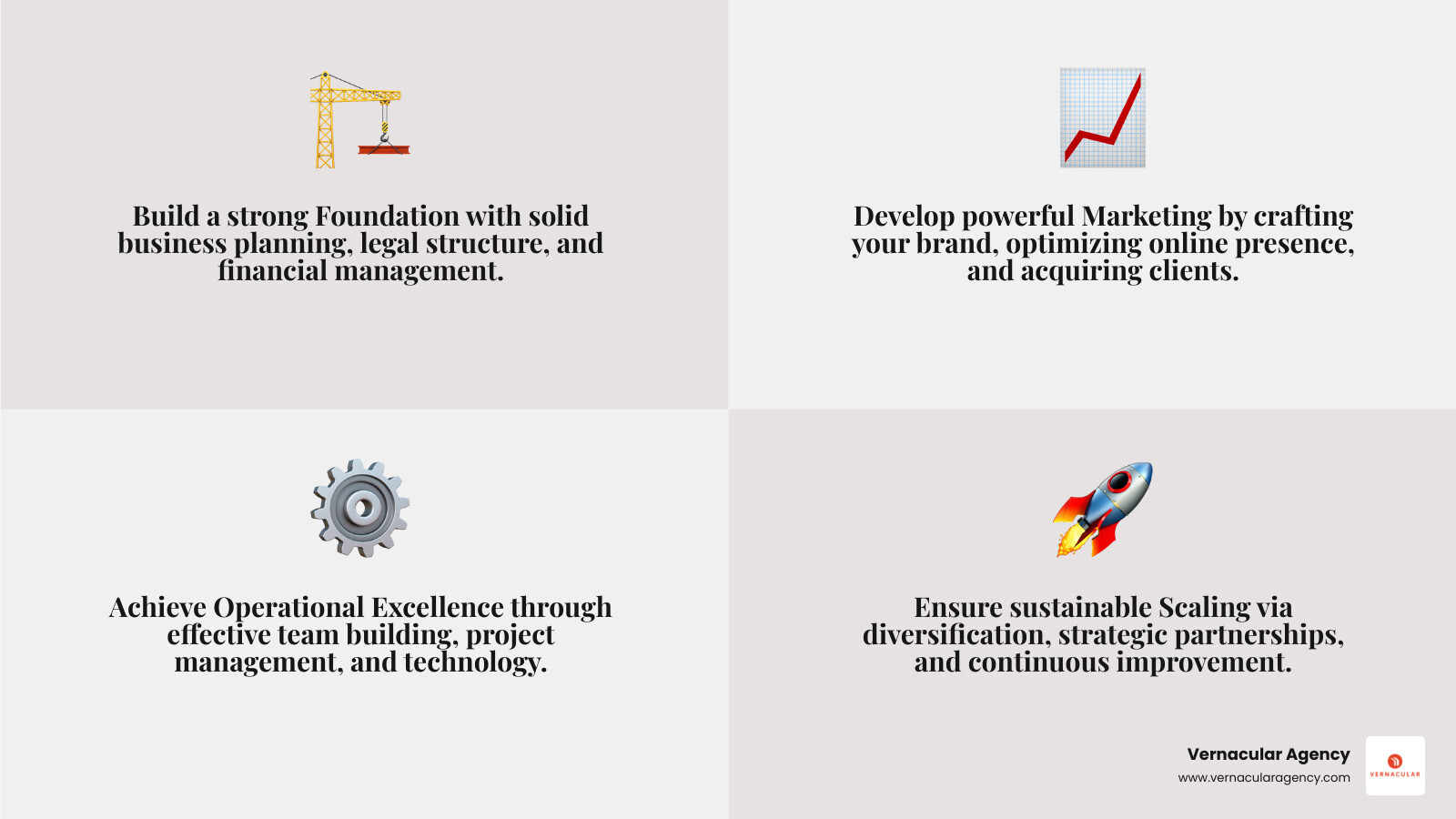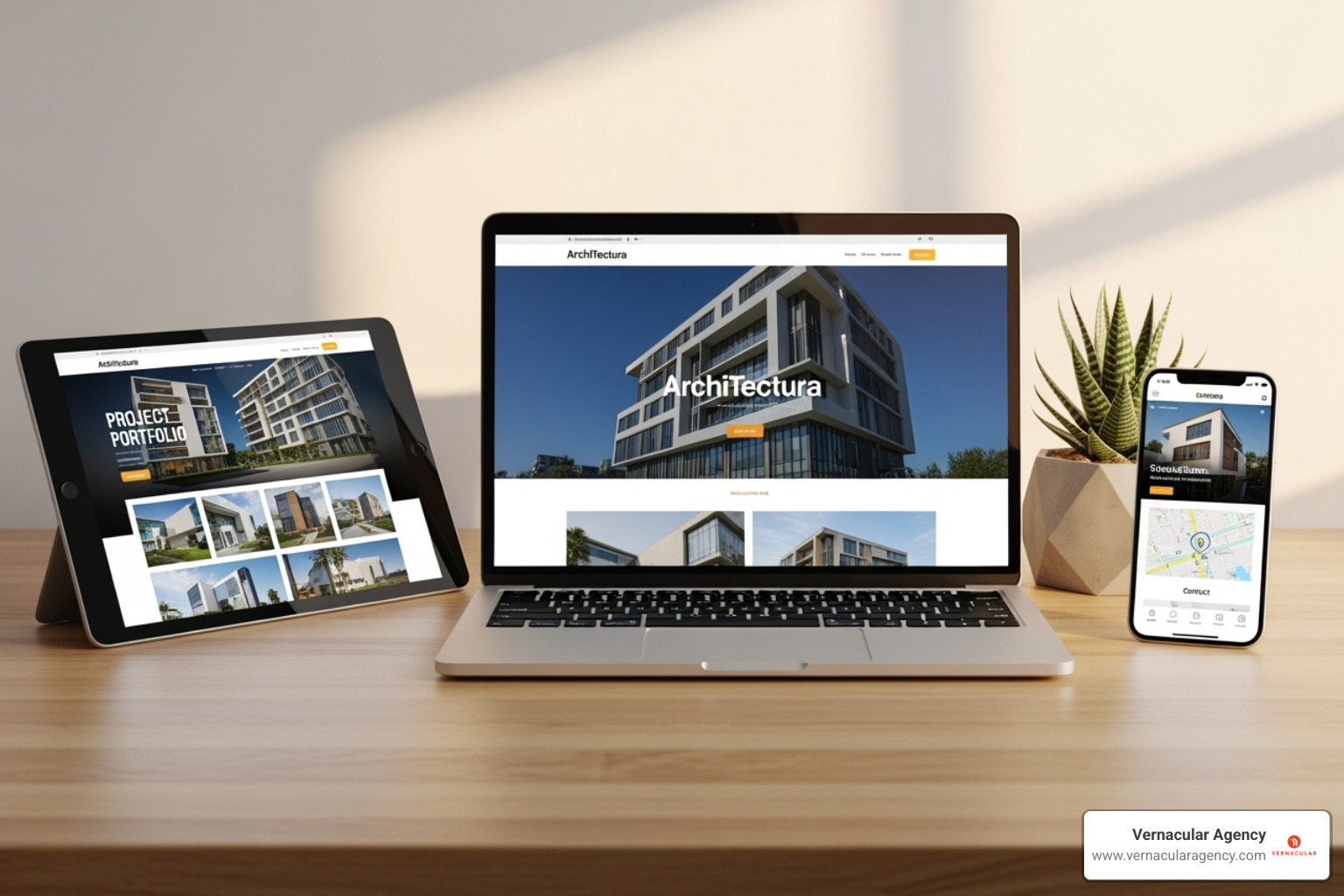Success in architecture isn't just about beautiful designs. The architecture services market is projected to grow at a compound annual growth rate of 4.8% through 2030, but many firms struggle to capture their fair share of this growth.
Quick Answer: How to Grow Architecture Business
Many architects believe they must choose between fulfilling projects and good income. High-performing firms prove this wrong by excelling at two jobs: marketing their services and providing them.
Most architects are trained in design, not business. A successful practice requires balancing design passion with smart business decisions, from financial forecasting to client acquisition. The firms that thrive have learned this balance.
As Rebecca Falzano, Creative Director with nearly 15 years of experience in design and content creation, I've worked closely with architecture firms to understand how to grow architecture business through strategic branding and marketing. My background has given me unique insights into the challenges and opportunities facing today's architectural practices.


Growing an architecture business starts with a solid foundation. Like a building, your practice needs proper planning and structure to succeed. Most architects are brilliant designers but lack formal business training. The firms that thrive master both the creative and business sides. Getting these basics right, whether you're a startup or an established practice, prevents future headaches and sets you up for long-term success.
Your business plan is the blueprint for your firm's success. It needs to be detailed, realistic, and actionable.
Your executive summary should articulate your firm's story and mission. The market analysis section is where you research ideal clients and local opportunities. The architecture services market is growing at 4.8% through 2030, but you must find where that growth is happening in your area.
Define your services offered specifically, but leave room for future expansion. Your marketing and sales strategy should outline how clients will find and hire you. Finally, the financial projections section is crucial. You need to understand startup costs, project profitability, and have a realistic timeline for reaching your financial goals.
At Vernacular Agency, we help firms gain clarity by putting their vision on paper and thinking through these practical details.
Your business structure is a critical decision that impacts liability and taxes. Making the right choice early on can save you significant trouble later.
| Business Structure | Best For | Growth Potential |
|---|---|---|
| Sole Proprietorship | Solo architects just starting out | Limited - personal liability is a major constraint |
| Partnership | Two or more architects working together | Moderate - shared resources but shared liability |
| LLC | Most growing firms seeking flexibility | High - good protection with operational simplicity |
| Corporation | Firms planning to scale significantly | Highest - best for attracting investment and major growth |
Most growing architecture firms choose an LLC structure for its personal liability protection and operational simplicity. Beyond the structure, you must handle business registration, obtain necessary professional licenses, and secure insurance coverage, especially professional liability insurance.
Good contracts are also essential. They protect you and your clients by setting clear expectations on services, responsibilities, and payment terms. Don't be afraid to enforce them.
Mastering your finances is essential for anyone wondering how to grow architecture business successfully.
First, you must secure capital through loans, personal investment, or partners to cover startup and operating costs until you're profitable. The average architecture firm carries about $70,000 in business debt, so plan accordingly.
Set up bookkeeping software and accounting systems from day one to track every dollar. This is vital for tax purposes and for understanding if your projects are actually profitable.
Understanding your key costs is crucial. Beyond rent and software, account for marketing, professional development, and non-billable business development time. Many architects underestimate these costs, leading to financial struggles even when they are busy.
Financial management isn't the most exciting part of running a firm, but it's what allows you to keep designing for years to come.

With a solid foundation, it's time to pull the levers for growth. This is where firms either thrive or struggle. Growth isn't about doing more of the same; it's about strategic choices that differentiate you. While 80% of architects are generalists, the fastest-growing firms often specialize.
The most successful architecture firms often serve fewer types of clients, not more. Trying to be everything to everyone makes you special to no one.
Specialization is your secret weapon. Commercial and industrial firms report the highest profitability at 14.8%. When you're known for something specific, like sustainable design or healthcare architecture, clients seek you out and pay for your expertise.
From a client's perspective, the choice is simple. They will hire the architect who has designed 50 similar buildings over a generalist. Becoming the go-to expert lets you charge more, win projects faster, and build a reputation that generates referrals. Your marketing becomes easier because you're not just better; you're the best at one thing.
A clever approach is to develop a "Trojan Horse" service—a pre-design offering like site ROI analysis or feasibility studies. This gets you in the door early and positions you for the larger project that follows.
While specialization defines who you serve, diversification expands what you offer them. This deepens your relationship with ideal clients, rather than making you a generalist.
Pre-design services like feasibility studies or master planning already account for 9% of industry billings. They engage clients earlier and establish you as a trusted advisor.
Expanding into complementary services like interior design, project management, or construction administration creates more revenue per client and strengthens relationships. You stay involved through the entire process instead of handing off the project after the design phase.
Some firms even explore ongoing relationships through operations and maintenance consulting, creating recurring revenue and leading to future renovation work.
The key is to choose services that improve your core expertise, not dilute it. Each addition should make you more valuable to your target clients.
Architecture is a relationship business, but many firms treat networking as an afterthought. Your network is often the difference between feast and famine.
Approach industry events and conferences strategically. Research attendees and focus on building genuine connections. Building relationships with complementary professionals like engineers and contractors creates a powerful, two-way referral network.
Strategic partnerships can be game-changers. Partnering with firms that have complementary strengths allows you to tackle bigger projects and enter new markets. A design-focused firm might team with one strong in technical delivery, for example.
Nurturing these professional relationships is one of your most important business development activities. Your network isn't just who you know; it's who knows and trusts the quality of your work.

Talented architects struggle if potential clients can't find them or understand what makes them special. Your brand isn't just a nice-to-have; it's the engine that drives sustainable growth. If your brand doesn't clearly communicate your value, potential clients will hire someone else. A powerful brand and marketing system is essential for long-term success.
Your brand is more than a logo; it's the feeling people get when they think about your firm. It's why a client chooses you. The strongest brands tell a story. What's your story? This story becomes your unfair advantage.
Great brands are built on the Four Ps: Purpose (why you exist), Promise (the unique value you deliver), Position (how you're different), and Personality (your firm's character). Your visual identity—colors, fonts, imagery—should consistently reflect this story.
At Vernacular Agency, our Brand Identity services help architecture firms find and express what makes them unique. This allows them to stop competing on price and start attracting clients who value their specific offerings.
A sobering fact: 84% of potential clients visit your website before making contact. Your website is your most important business development tool, and many firms are eliminated based on their site alone.
Your website must quickly answer: What do you do? Who for? What problem do you solve? What's the next step? If a visitor has to hunt for these answers, you've lost them.
Use client-focused design and a portfolio that showcases the types of projects you want more of. Professional photography should tell the story of how spaces feel. Clear calls-to-action like "Schedule a Consultation" should guide visitors. Your site must also be fast, mobile-optimized, and secure to build trust.
We understand the unique challenges of Website Design for Architects. It's about creating a marketing machine that works 24/7 to attract your ideal clients.
Relying only on referrals is "Hope Marketing," and hope is not a strategy. Proactive digital marketing is necessary to consistently attract ideal clients.
Content marketing positions you as an expert. Share valuable insights through blogs or videos that answer the questions your ideal clients are asking. SEO ensures people can find your content when searching online. This isn't about stuffing keywords; it's about being genuinely helpful.
Build authority by sharing your expertise beyond your own website, such as speaking at events or writing guest articles. Use email marketing to nurture leads over time, as architecture projects have long decision cycles. A social media presence on platforms like LinkedIn and Instagram helps you stay connected and showcase your firm's personality.
Digital marketing requires consistency and patience. It's about building a system that attracts ideal clients month after month. Our specialized SEO Strategies for Architects help firms create sustainable growth that doesn't depend on hoping the phone will ring.

Stunning designs and brilliant marketing aren't enough. Without solid operations and a focus on profitability, your firm won't survive. This is the nuts-and-bolts reality of how to grow architecture business sustainably, and it's crucial for making a lasting impact.
Your team is the heart of your firm. Every success flows from the people you hire. When hiring for skill and culture fit, look beyond portfolios. Does a candidate share your vision and collaborate well? A disruptive but talented designer can do more harm than good.
Fostering collaboration creates an environment where everyone works toward the same goals and feels comfortable sharing ideas. Investing in professional development through training and mentorship is essential for retention. When your team feels they're growing, they're more likely to stay.
Many architects struggle with the business side. Empowering your team might mean hiring someone with strong business acumen to handle administrative tasks, freeing you to focus on design. The strongest firms have complementary skills, blending creative visionaries with detail-oriented project managers and client-focused relationship builders.
Profit isn't a dirty word. It's what allows you to take on passion projects, invest in technology, and build the firm of your dreams.
Key Performance Indicators (KPIs) are your firm's vital signs. You shouldn't run a business without understanding these metrics:
Using practice operations software turns these numbers into visual dashboards. You can see planned profits and identify which projects, teams, or clients are most profitable. A key insight: high-performing firms are 10% more likely to be on or ahead of schedule, which directly impacts profitability.
New clients are exciting, but 70% of firm billings come from repeat clients. Your existing relationships are your most valuable asset.
Exceptional customer service means being responsive, communicating clearly, and handling challenges with professionalism. Nurturing relationships with simple things like an email newsletter keeps you top-of-mind for future projects and referrals.
Don't just hope for referrals; actively seek them. Be specific about the work you're looking for, such as, "we're interested in more sustainable residential projects."
Identifying your 'A' clients—those who value your expertise, pay on time, and are a pleasure to work with—is a game-changer. Once you know your ideal client profile, you can actively seek more like them, creating a blueprint for business development success.
We've helped many architecture firms grow and have seen the same questions arise repeatedly. If you're wondering how to grow architecture business, you likely share these common concerns.
Understanding common roadblocks can help you prepare for them.
Being small can be an advantage if you play your cards right.
After working with dozens of firms, one factor consistently separates the thriving from the struggling: developing a repeatable system for attracting and winning ideal clients.
This isn't about luck or random marketing. It's an engine that consistently brings qualified prospects to you. The system combines three elements:
When these elements work together, the system feeds itself, changing growth from a constant struggle into a sustainable, enjoyable process.
Building a thriving architecture practice means creating a beautiful business that supports your design passion. The journey of how to grow architecture business requires you to be a designer, marketer, and strategic business owner.
We've covered the essential building blocks: a solid foundation with a clear business plan, strategic growth levers like specialization, a powerful marketing engine, and operational excellence focused on profitability and client retention. When 70% of billings come from repeat clients, it's clear that great service is the cornerstone of sustainable growth.
The long-term benefit is more than just profit; it's the freedom to choose projects that inspire you, invest in your team and technology, and build a stable practice that can weather any economic storm. You're not just building a business—you're creating a platform for lasting architectural impact.
The most successful architects understand that great design and smart business strategy are complementary forces. When combined, they create something truly powerful.
To build a thriving practice, you need a solid foundation and a powerful marketing strategy. Let us help you build your empire with our expert Marketing Services.